 Facebook
Facebook
 X
X
 Instagram
Instagram
 TikTok
TikTok
 Youtube
Youtube
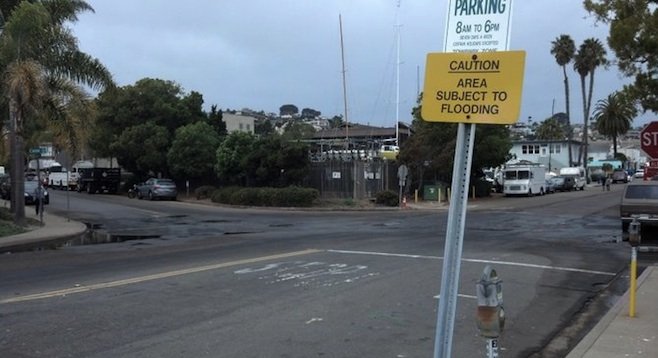
King tides, the highest of high-water marks that come around just a few times each year, became evident at beaches and bays across San Diego during the past week.
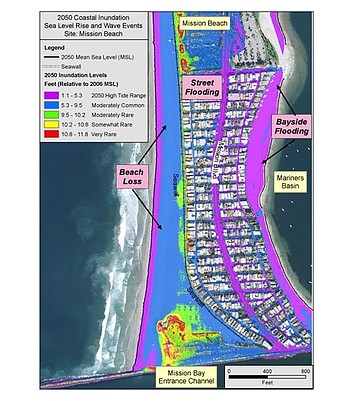
Environmental and water-quality advocacy group San Diego Coastkeeper used the occasion to illustrate challenges local coastal communities will face with an expected rise in sea levels of 12 to 18 inches between now and 2050.
"These king tides represent what we need to plan for and show us how we need to build going forward," says Megan Baehrens, Coastkeeper's executive director. Baehrens and program director Travis Pritchard conducted bay tours January 29–31 to help visualize what environmentalists say is the coming "new normal" with sea-level rise and the impact it will have on the coastline.
On January 30, I was invited to join Coastkeeper's boat.
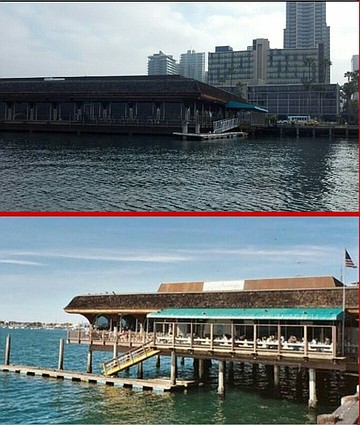
The first stop on the tour was in the Embarcadero, offshore from Anthony's Fish Grotto. During a normal tide, the building sits over the water on pilings extending up several feet to the restaurant's floor. On Thursday morning, with the tide estimated at 6.7 feet (tides Wednesday reached a high of over 7.1 feet), the pilings were nearly invisible as the water came within inches of the building.
Similar conditions were observed in Coronado, where a sandy beach at the edge of the municipal golf course was completely submerged, and another building normally several feet above the water line had swells lapping at the foundation.
"These properties have a limited life span," said Baehrens, who believes that cities along the coast need to take sea rise into account when planning future storm-drain systems, roads, and coastal access, as well as scale back development in areas that will eventually become submerged — a practice called "managed retreat" in environmental circles.
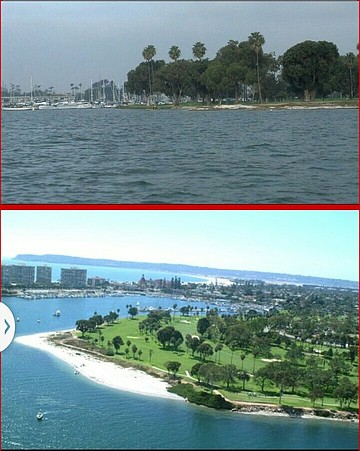
"If you have sea-level rise and a high tide and then a storm surge, it'll cause serious problems," said Pritchard. "When you talk about sea-level rises, you can't think in averages; you have to consider the extremes."
Some parts of town are already experiencing negative effects from high tides. Sharon Cloward, who represents the San Diego Port Tenants Association and was along for the tour, said inadequately designed storm drains would often fill and flood intersections near the bay during high tides.
Cloward directed me to the intersection of Cañon Street and Anchorage Lane, which she said frequently flooded to the point that police have to be called upon to warn motorists against attempting to drive through.
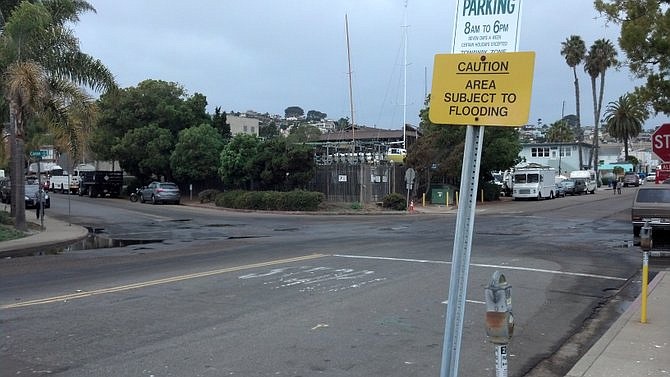
I visited the location more than two hours after the high tide on January 30 and puddles remained at the corners, evidence of flooding earlier in the day.
"What these tides represent is the inevitable sea-level rise that is coming with climate change. We're seeing businesses, homes, and public spaces all being encroached upon by water," said Baehrens. "We need to work to lower greenhouse gas emissions as much as possible now and slow the [sea rise] down while we build natural buffers and infrastructure that can deal with what's coming."


King tides, the highest of high-water marks that come around just a few times each year, became evident at beaches and bays across San Diego during the past week.

Environmental and water-quality advocacy group San Diego Coastkeeper used the occasion to illustrate challenges local coastal communities will face with an expected rise in sea levels of 12 to 18 inches between now and 2050.
"These king tides represent what we need to plan for and show us how we need to build going forward," says Megan Baehrens, Coastkeeper's executive director. Baehrens and program director Travis Pritchard conducted bay tours January 29–31 to help visualize what environmentalists say is the coming "new normal" with sea-level rise and the impact it will have on the coastline.
On January 30, I was invited to join Coastkeeper's boat.

The first stop on the tour was in the Embarcadero, offshore from Anthony's Fish Grotto. During a normal tide, the building sits over the water on pilings extending up several feet to the restaurant's floor. On Thursday morning, with the tide estimated at 6.7 feet (tides Wednesday reached a high of over 7.1 feet), the pilings were nearly invisible as the water came within inches of the building.
Similar conditions were observed in Coronado, where a sandy beach at the edge of the municipal golf course was completely submerged, and another building normally several feet above the water line had swells lapping at the foundation.
"These properties have a limited life span," said Baehrens, who believes that cities along the coast need to take sea rise into account when planning future storm-drain systems, roads, and coastal access, as well as scale back development in areas that will eventually become submerged — a practice called "managed retreat" in environmental circles.

"If you have sea-level rise and a high tide and then a storm surge, it'll cause serious problems," said Pritchard. "When you talk about sea-level rises, you can't think in averages; you have to consider the extremes."
Some parts of town are already experiencing negative effects from high tides. Sharon Cloward, who represents the San Diego Port Tenants Association and was along for the tour, said inadequately designed storm drains would often fill and flood intersections near the bay during high tides.
Cloward directed me to the intersection of Cañon Street and Anchorage Lane, which she said frequently flooded to the point that police have to be called upon to warn motorists against attempting to drive through.

I visited the location more than two hours after the high tide on January 30 and puddles remained at the corners, evidence of flooding earlier in the day.
"What these tides represent is the inevitable sea-level rise that is coming with climate change. We're seeing businesses, homes, and public spaces all being encroached upon by water," said Baehrens. "We need to work to lower greenhouse gas emissions as much as possible now and slow the [sea rise] down while we build natural buffers and infrastructure that can deal with what's coming."
Comments